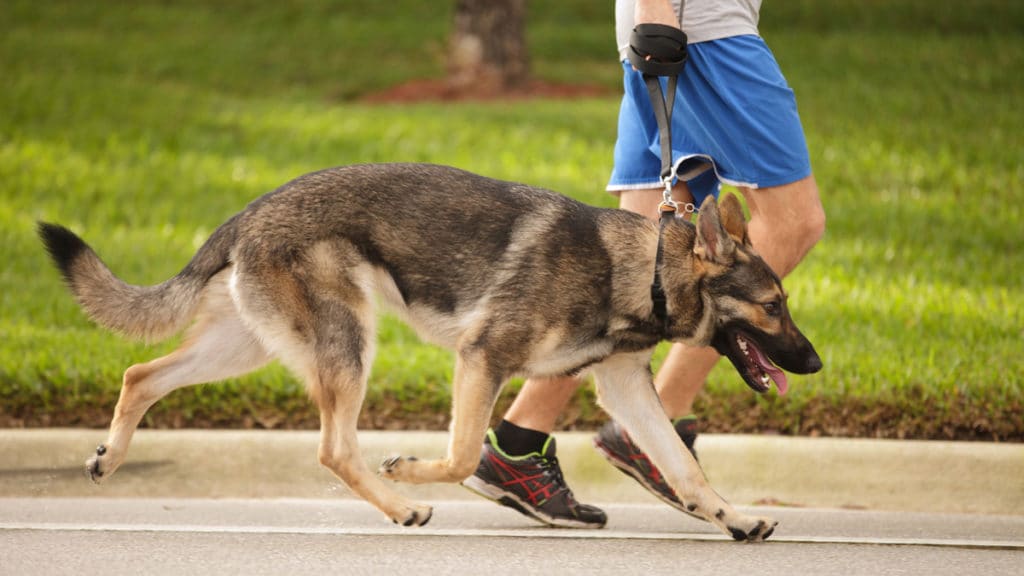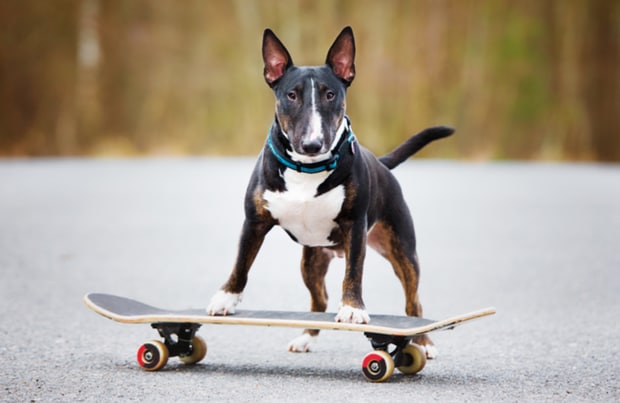Exercising with your pup is not only fun, but also a great way to keep him and yourself in shape together. Running with your dog is definitely a way to bond with your four-legged friend while doing something you both love. Here are the things you need to know before running with your dog to make sure he’s ready. If he is, this guide will also provide safety tips for your runs.
Schedule a Trip to the Vet
Before bringing your dog on a run, you should consult your veterinarian to make sure your pup is up to the task.
“All dogs need lots of enrichment and exercise—physical and mental, but running long distances is not for every dog,” says Russell Hartstein, certified dog/cat behaviorist and trainer and CEO (Canine Executive Officer) of Fun Paw Care in Los Angeles.
Some dog breeds are not equipped for such a physically taxing activity. Age also is a factor. Many breeds are not done growing for a couple of years, and any dog that is still developing should not be running just yet. The hard pavement can be bad for their growing joints, muscles and bones.
“Do not run long distances with a puppy or any dog under 1 year old,” Hartstein says. “This varies with health status and breed, but in general, puppy bones are not formed yet, and it is not healthy to run long distances with puppies.”
The same goes for canines who have entered into their golden years.
Reach out to your veterinarian to make sure your dog is in adequate physical health and to ask how to safely incorporate running into your pup’s routine.
Run With the Right Supplies
Before getting started, you’ll want to make sure you have the appropriate supplies.
Hands-Free Leashes
In addition to reflective gear, a hands-free leash, like Waggin’ Tails’ Smart 3-in-1 Hands Free Dog Leash, can be a valuable tool for running with your dog. These leashes use a bungee design, which allows you and your dog to run together without feeling like you are tugging on each other.
Training your running dog to run in sync with you rather than ahead of or behind you is aided by the hands-free waist leash.
“Hands-free leashes free up your hands to run naturally,” Hartstein explains. “I would also make sure to have a carabiner-locking clasp on your dog leash to make sure it does not come off.”
Dog leash lengths can vary, so experiment with what makes you both comfortable.
“Typically a 6-foot leash works well,” Hartstein says.
Reflective Gear
Whether you are in an urban or rural area, be sure that both you and your dog wear reflective vests or apparel. Roadways do not always have designated sidewalks or streetlights, so it is crucial to wear clothing that alerts drivers, bikers and other runners to you and your pup. SafetyPUP’s XD Reflective Dog Vest is one such option that helps provide your pet with visibility in both daytime and low-lighting settings.
Reflective leashes, like Hertzko’s Hands-Free Running leash, which features reflective stitching, are also a great way to keep you and your pet safe while running on the roads.
Running on the opposite side of the road against traffic is the safest way to make sure you see oncoming vehicles, and is the law in many states. Unfortunately, distracted driving is common, so vigilance on your part is essential when running with your dog. Stay alert and stay aware.
Water for Two
You should always make sure to bring a water bottle or water source for your pup while on runs. Slowly providing your pet with water throughout a long-distance run and not simply throwing down a bowlful at the end helps prevent your dog from taking in water too quickly. Dogs benefit from drinking water during the run in small doses, allowing them to get the right amount of hydration to become long-distance running dogs. Bring portable water bowl with you to keep your pet hydrated, like Petmate’s collapsible pet bowl, which can be attached to your leash.
Timing Is Everything
Where you live will determine the safest time of day to take your dog running. If you are located in a warm climate or are running during the summer, it is best to go early in the morning or in the evening, as the pavement will likely be cooler. Running midday in direct sun is not a good idea for you or your running partner. The hot weather can cause dehydration, and the hot pavement can injure your pup’s paws.
If you happen to be in a cold climate or are running during winter months, the warmest part of the day is best. You should also make sure the roads are clear of slippery ice and paw-damaging salt. When in doubt, sit it out.
“Always consider the temperature, humidity and environment in which you will be running,” Hartstein says.
Accompanying your run with some form of paw protection, like Dr. Tim’s paw wax or Ethical Pet Fashion’s All-Weather pet booties, is a great way to keep your pup’s paws protected in both hot and cold weather. You should also bring along water, and more when it is hot, to help prevent dehydration and injuries.
Take It One Step at a Time
Slow and steady wins the race. If you have the all clear from your veterinarian, start training in slow strides. Like any exercise done without stretching first, you can push it too far and injure yourself. The same goes for running too quickly with your dog.
Begin your first week off with a shorter distances, and then start adding on each following week. This gives your canine the ability to grow in a stable way as a companion runner. Running long distances right away can lead to injuries if your dog is not fit or strong enough.
“Gradually build into it, and start slow before a long run,” Hartstein says.
Above all else, pay attention to your dog and look for signs that he is not enjoying himself. If your dog is panting heavily or stopping a lot, it’s time for a break.
“Dogs are individuals, and just because you are a long-distance runner does not mean it is healthy for your dog or they enjoy it,” Hartstein says. “Make sure it is mutually enjoyable and healthy.”
With the right planning, training and veterinary advice, you can decide on the best possible way to go about pet exercise. Whether it is jogging, walking, playing or running with your dog, exercising with your pet can be a rewarding experience.

Leah McCormack is a New England native and dog lover. She graduated from the Fashion Institute of Technology in New York City with her bachelor’s degree and started her animal care business, Winni Pups. Her published articles and features can be found in The Boston Globe, The EveryGirl, The Improper Bostonian, Mane Addicts, WGSN and Chewy.
Share:















